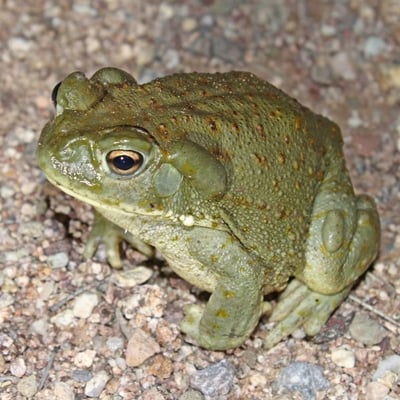 Dogs love to taste everything, even toads! While that might be safe in most of the country, in many areas of the United States, licking or even placing a toad in their mouth is a dangerous endeavor for a pet.
Dogs love to taste everything, even toads! While that might be safe in most of the country, in many areas of the United States, licking or even placing a toad in their mouth is a dangerous endeavor for a pet.
While most toxicities happen to dogs – likely due to their curiosity – the toads we mention in this article are toxic to cats, as well.
So, it's good to be aware of what toxic toads are in your area or where you travel and what to do if you suspect your pet has had a run-in with one. In most areas of the country, toads cause only drooling and mild vomiting that do not require veterinary attention. But if you are in the areas below, keep an eye out for these toads and symptoms in your pets, as toad poisoning is very common.
The North American Toxic Toads
Cane Toads (aka Bufo, Giant, Black, or Marine Toad) – Rhinella marina
 They are native to the southern tip of Texas, through Mexico, and down into South America. These are burrowing toads that come out into the open during wet periods of the year. They are found in cities, suburbs, and rural areas.
They are native to the southern tip of Texas, through Mexico, and down into South America. These are burrowing toads that come out into the open during wet periods of the year. They are found in cities, suburbs, and rural areas.
Where Cane Toads Are Found in the United States:
- Florida
- Louisiana
- Mississippi
- Hawaii
- South Texas
How to Identify Cane Toads:
- 6–9 inches in length
- The top is reddish-brown to grayish-brown
- The belly is light yellow or tan
- The tadpoles are black
- There is a large triangular poison gland along the shoulder
- There are no ridges or crests on the head
The Risk to Your Pet:
Cane toad poisoning can cause death, especially without treatment. Any pet exposed to Cane toads should see a veterinarian immediately after rinsing the mouth.
Listen to the cane toad call in the video below.
Colorado River Toad (aka Sonoran Desert Toad or Sapo Grande) – Incilius alvarius
 These toads live underground until the monsoon season, when they rise above the ground. They are most active at night and may hide in burrows and between rocks during daylight.
These toads live underground until the monsoon season, when they rise above the ground. They are most active at night and may hide in burrows and between rocks during daylight.
Where Colorado River Toads Are Found in the United States:
- Arizona
- New Mexico (threatened)
- Southern California (possibly extinct)
- Mexico
How to Identify the Colorado River Toad:
- 4–7.5 inches in length – it's the largest native toad in the United States
- The top is olive, dark brown, or dark gray with a pale throat
- Adults have smooth skin
- Young have light-colored warts set within dark spots
- All toads have a white wart near the corner of the mouth and large warts on the back legs
- There is a large poison gland behind the eyes
The Risk to Your Pet:
Colorado River toad poisoning rarely causes death with treatment, except through secondary heat stroke. If a dog licks a toad, rinsing the mouth may relieve signs within 30 minutes, but a veterinarian should be contacted for all toad exposures.
Listen to the call of the Colorado River Toad (Sonoran Desert Toad).
How Pets Become Exposed to Toxic Toads
Pets are poisoned by licking, mouthing, or eating toxic toads (including the young tadpoles) and their eggs, which also discharge the toxin. Dogs are more likely to eat or lick toxic toads than cats, mainly because of the toads' large size. Dogs are sometimes exposed to the toxin from a water bowl where a toad has rested.
Smaller dogs and cats may become exposed by eating or licking younger toads, tadpoles, or the toads' eggs.
Pets are more likely to be exposed at night when toads are more active.
Note: Humans can be exposed to the toxins handling toads, tadpoles, and eggs. Wear gloves if handling potentially toxic toads!

Symptoms of Exposure to Toxic Toads
The poisons in the Cane Toad and Colorado River Toad have three main types of toxins which cause the following signs:
Topical Irritant – these occur immediately after contact with the toad.- Drooling
- Gagging
- Vomiting
- Whining
- Pawing at the face
- Difficulty breathing (in some cases)
- Weakness / Low blood pressure
- Irregular Heart Rhythm
- Sudden death (in some cases)
- Difficulty walking
- Stiff muscles
- Hyperthermia (elevated body temperature)
- Seizures (in some cases)
Severe signs are most likely in the following scenarios:
-
A pet has underlying heart disease. Depending on the dog’s heart disease, the dog may have difficulty handling the toxin’s effects on the heart, even with treatment.
-
A dog has swallowed the toxic toad. Eating the toad gives a hefty dose of toxin. Cats and small dogs are less likely to swallow an entire toad, although they may eat eggs, tadpoles, or younger toads.
-
If a toad rests in the pet’s water bowl, a significant amount of toxin leaches into the water. If a dog or cat drinks from the bowl, this can lead to severe symptoms.

What You Should Do If You Know or Suspect Your Pet Licked or Ate a Toxic Toad
- Use a hose or sprayer to rinse your pet’s mouth from BACK TO FRONT for at least 5 minutes. Rinsing back to front prevents your pet from swallowing the water and the toxins in the rinse. Point the head downward to help avoid swallowing. If your pet is swallowing the water, redirect the flow or try from the other side of their mouth. If you are having a lot of difficulty, allow your veterinarian to do this.
- After you rinse your pet’s mouth, if your dog or cat has any of the following signs, please also hose them down before heading to the veterinarian. These may be signs of heat stroke.
Note: many of the signs of heat stroke overlap with toad toxicity, but the body temperature at or above 104°F is an indicator of heat stroke:
- Rectal or armpit temperature at or above 104°F
- A lot of panting
- Tongue hanging low
- Brick red gums
- Difficulty walking
- Weakness
- Seizures
- Vomiting or diarrhea
- After you have rinsed for 5 minutes, get your pet to a veterinarian immediately. Call the veterinarian before you leave and tell them your pet may have eaten or licked a toxic toad and your pet’s symptoms. If your local veterinary clinic is not equipped to monitor your pet, they may refer you to a local 24-hour emergency or referral clinic.
Treatment of Toad Intoxication
There are two main goals of treatment:
-
Remove as much of the toxin as possible before it is absorbed. If it has been several hours, then treatment shifts entirely to #2.
-
Alleviate the signs caused by toad intoxication.
When you arrive at the veterinarian’s office, the veterinarian will ask if you know for sure if your pet licked or ate a toxic toad or if this is a suspected toad exposure.
If this is a suspected exposure, the veterinarian will consider other possible causes of your pet’s signs, such as ingestion of heart medications, toxic plants, pesticides, caffeine, chocolate, and human cold medications.
Diagnostics and Monitoring
The veterinarian will perform a history and physical examination. Additional information is very helpful in establishing not only the diagnosis (if it is in question) but also your pet’s treatment plan.
Blood Pressure
Some pets with toad toxicity develop low blood pressure, which can lead to kidney failure if it is prolonged.
Electrolytes and Chemistry
Changes in potassium, calcium, or magnesium levels may lead to arrhythmias. BUN and Creatinine are used to monitor kidney function.
Electrocardiogram (ECG)
The ECG detects unusual heart rhythms (arrhythmias). The veterinarian may keep the ECG on your pet for the duration of their hospitalization.
Removing the Toxin
If your pet licked the toad, you (or your vet) should wash out the mouth thoroughly for 5 minutes, with the hose pointed toward their nose.
If the pet ate the toad, the safest options are endoscopy or surgery to remove the toad under anesthesia. Endoscopy is a lighted scope with a camera passed into the stomach. If the ingestion is recent, the veterinarian operating the endoscope may be able to identify the toad and retrieve it.
Surgery may be chosen if the toad has moved into the intestines. Inducing vomiting is a riskier option since there is the risk of aspiration pneumonia and exposure of the esophagus and mouth to more toxin. Never induce vomiting on your own; you could cause more harm to your pet.
Pets with critical heart effects may benefit from human digoxin Fab fragments (Digibind), which bind the heart toxins but not the neurotoxins. Intravenous lipid therapy may also reduce both the heart toxins and neurotoxins.
Alleviating the Signs of the Toad Toxins
Intravenous fluids will help relieve low blood pressure. Anti-nausea medications, such as maropitant, may reduce nausea and vomiting.
Arrhythmias will be treated based on the ECG and lab results with anti-arrhythmic medications, electrolytes, calcium, and/or magnesium. Dogs or cats who are having difficulty breathing will benefit from oxygen therapy.
Stiff muscles are treated with muscle relaxants. Seizures are treated with anti-seizure medications such as diazepam.
Pets showing signs of hyperthermia (elevated body temperature) will be slowly cooled and treated for signs of heat stroke if needed.

How to Help Your Pet Avoid Toxic Toads
Teach Your Dog to 'Leave It'
To keep your dog safe from toxic toads, teaching them to leave them alone in the first place is crucial. This is a hard ask! Dogs are naturally attracted to check out small moving creatures. Start with teaching the basics of Leave It. This relies on you giving the verbal cue to leave something alone.
But you won't always be around to tell your dog to avoid the toads! For these scenarios, you can teach a dog an automatic leave it. This is the same technique we use for teaching snake avoidance. No need to use shock collars – instead, you teach a pattern to your dog so they know to come back and alert you when they scent or see a toad. Learn more about training an automatic leave it in our snake aversion article here.
Cats Are a Bit Different
Since we haven't bred out their natural predatory instincts, it's less likely that cats will respond to a trained cue like "leave it" if their prey drive kicks in. Give it a shot by using the "leave it" techniques linked in the dog section above.
If you live in an area where toxic toads are common, be careful with your cat's outdoor time. Supervise them if possible. Try a catio with mesh small enough to keep toads out, or avoid letting your cat out when toads are most active. Our friends at Feline Behavior Solutions all have homemade catios for their cats, as featured in the photo above.



